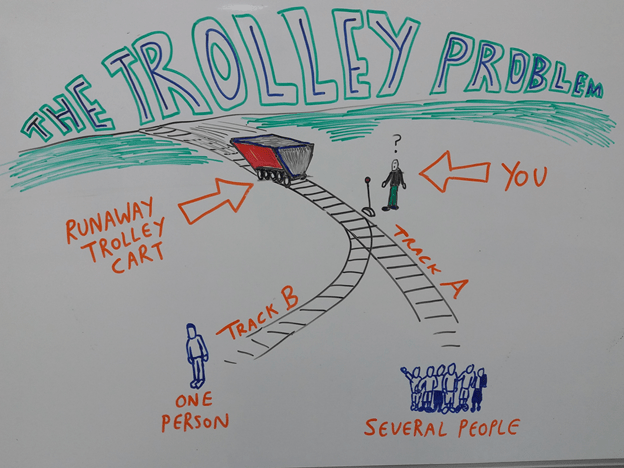Exploring the Trolley Problem in ELT Classes
The trolley problem is a concept often used in philosophy and ethics courses. If you haven’t heard of it before, it basically works like this:imagine you’re standing beside a railway line (the reason why you’re there isn’t important). You suddenly see a large, heavy, unmanned train car (or trolley) coming down the track. It’s out of control and hurtling toward you at lethal speed.
You’re safe, but further down the track is a group of people who will almost certainly all be killed if the out-of-control trolley continues rolling along the track. There’s no time to shout a warning to those people or help them in any other way, except that you happen to be standing near a junction of the track, and the lever which controls whether trains or trolleys travel down a different track is right next to you.
You now have to make a decision.
You can either do nothing, and allow the runaway trolley to continue along the track it’s already on. Or, you can pull the lever and send the trolley along a different track. If the trolley goes down the alternative track, it will hit and kill one person.
What would you do?
Sometimes the situation is like the one above, would you deliberately act to kill one person in order to save several more? It’s a problem that has been popularized recently by philosophers such as Michael Sandel, although the basic question has been explored countless times over the years, and if you teach teenagers or adults it’s quite possible that your students will have already encountered it in their native language. In Taiwan (where I live) it’s taught as part of the curriculum in most public high schools.
How can the trolley problem be used in ELT?
The ‘what would you do’ question presents a good opportunity to revise second conditional structures in English language classes, and on its own, it’s a good conversation topic with learners at intermediate level or above, as well as a useful basis for debate and critical thinking. However, it’s possible to add a ‘twist’ to this question which will really get your learners to think.
Trolley problem with a twist
Firstly, explain the trolley problem to your learners – using your whiteboard to draw the scene will help. Then pose the ‘What would you do?’ question to your learners.
If they would allow the train, trolley or cart to continue along the track it’s already on – let’s call it Track A – sealing the fate of the group of people further down that track, they should sit in one section of the room.
If they would pull the lever, saving the larger group of people on Track A but leading to the death of one person on Track B, they should sit in a different section of the room. Ask a few of them to say why they made their decision.
Then, explain the ‘twist’. Students will read cards (see appendix) which provide information about either the people on Track A or the person on Track B. The cards should be arranged face down on a table at the front of the room. The information on the cards tells the reader something about either the people on Track A or the person on Track B.
Don’t say it!
Ask one member of the group to come to the front and read one of the cards without saying it aloud or showing it to anyone else. They can take a few moments to ponder their decision before placing the card in a box and either returning to their original place or changing their mind and going to sit with the other group. There should be a growing sense of intrigue as members of the original Track A group switch to the Track B group and vice versa, while others return to where they were before.
The reason why the learners should read the card but not say it aloud is to show how what we think is not always the same as how we act, which should be demonstrated by the next stage.
Following the crowd?
After all of the cards have been read, ask one member of the class to take them out, one by one, and read them aloud. This time, everyone will make their decisions at the same time – to stay where they are, or move to the other group.
Some members of your group may find themselves constantly switching places as they hear the different scenarios. Others will adamantly remain exactly where they started. The main job for the teacher at this stage is to encourage learners to say why they made those decisions.
Raising awareness of ethics
A useful additional question comes at the end – ask them to raise their hands if the decision they made in secret – when nobody else knew what was on the card – was the same as the one they made when everyone else had access to that information (this stage is mainly for awareness-raising; learners shouldn’t have to say which cards led to different decisions). You might be surprised by how many of them admit to making different decisions when the information was private than when they perhaps felt they ought to follow the crowd. This can lead on to fruitful discussions and debates on topics such as peer pressure, secret ballots and voting, revenge and retribution, and whether we should always tell the truth.
What would you do?
If you’ve used activities like this in your classroom, has it been successful? What other ideas from philosophy and ethics can be utilized in ELT?

The people on track A are all members of your favourite pop or rock group.
The person on track B is a five-year old girl.
The person on track B is a murderer and has already killed seven people.
The people on track B are there because they are dying and wanted to see the view from the nearby railway bridge for the final time.
The people on track A are terrorists who blew up an important building in your city a few hours ago, killing many people.
On track A, the peopleare gang members waiting to attack another gang.
The person on track B is deaf and blind.
The people on track A are all over 90 years old.
The person on track B is waiting to give you a bag with one million dollars inside. The money will be destroyed if the cart goes down track B.
The person on track B is waiting to give you a bag with one hundred million dollars inside. The money will be destroyed if the cart goes down track B.
References
- Sandel, M (2009) Justice: What’s the Right Thing to Do? Penguin books
You may read this article as well My DELTA Diary: Module 2 Intensive Course
You may read Global Approach To Phrasal Verbs article. This article originally appeared in ELTAS News earlier this year. It is reposted with Rita Baker’s kind permission.




